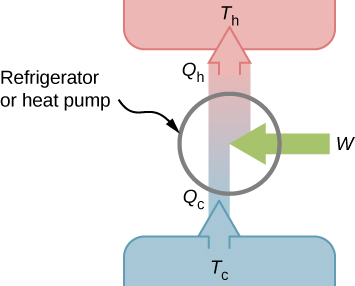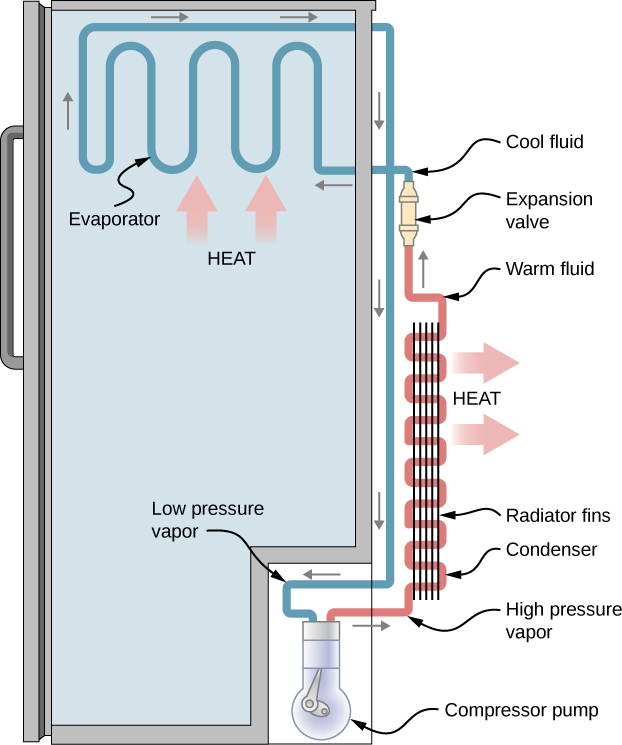4.4: Refrigeradores e bombas de calor
- Page ID
- 184600
Ao final desta seção, você poderá:
- Descreva uma geladeira e uma bomba de calor e liste suas diferenças
- Calcule os coeficientes de desempenho de refrigeradores e bombas de calor simples
Os ciclos que usamos para descrever o motor na seção anterior são todos reversíveis, então cada sequência de etapas pode ser executada com a mesma facilidade na direção oposta. Nesse caso, o motor é conhecido como refrigerador ou bomba de calor, dependendo do foco: o calor retirado do reservatório frio ou o calor despejado no reservatório quente. Um refrigerador ou uma bomba de calor é um motor funcionando em sentido inverso.
- Para um refrigerador, o foco é remover o calor de uma área específica.
- Para uma bomba de calor, o foco está em despejar calor em uma área específica.
Primeiro, consideramos uma geladeira (Figura\(\PageIndex{1}\)). O objetivo deste motor é remover o calor do reservatório de frio, que é o espaço dentro da geladeira para um refrigerador doméstico real ou o espaço dentro de um prédio para uma unidade de ar condicionado.

A refrigerator (or heat pump) absorbs heat \(Q_c\) from the cold reservoir at Kelvin temperature \(T_c\) and discards heat \(Q_h\) to the hot reservoir at Kelvin temperature \(T_h\) while work W is done on the engine’s working substance, as shown by the arrow pointing toward the system in the figure. A household refrigerator removes heat from the food within it while exhausting heat to the surrounding air. The required work, for which we pay in our electricity bill, is performed by the motor that moves a coolant through the coils. A schematic sketch of a household refrigerator is given in Figure \(\PageIndex{2}\).

The effectiveness or coefficient of performance \(K_R\) of a refrigerator is measured by the heat removed from the cold reservoir divided by the work done by the working substance cycle by cycle:
\[K_R = \dfrac{Q_c}{W} = \dfrac{Q_c}{Q_h - Q_c}\]
Note that we have used the condition of energy conservation, \(W = Q_h - Q_c\), in the final step of this expression.
The effectiveness or coefficient of performance \(K_P\) of a heat pump is measured by the heat dumped to the hot reservoir divided by the work done to the engine on the working substance cycle by cycle:
\[K_P = \dfrac{Q_h}{W} = \dfrac{Q_h}{Q_h - Q_c}.\]
Once again, we use the energy conservation condition \(W = Q_h - Q_c\) to obtain the final step of this expression.


